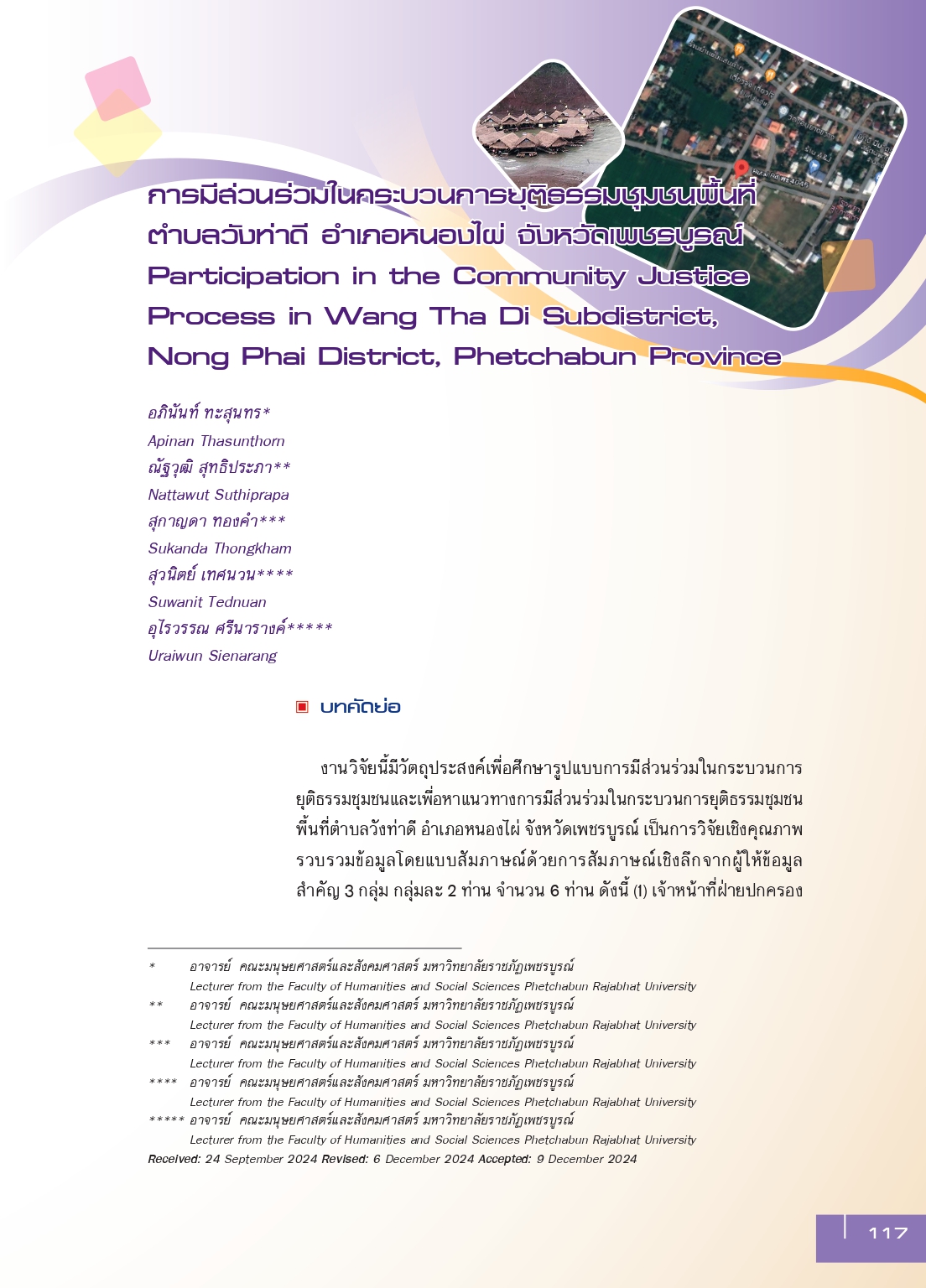Participation in the Community Justice Process in Wang Tha Di Subdistrict, Nong Phai District, Phetchabun Province
Main Article Content
Abstract
The aims of this research are to study the patterns of participation in the community justice process and identify approaches for participation in the community justice process in Wang Tha Di Subdistrict, Nong Phai District, Phetchabun Province. Qualitative research was applied via in-depth interviews of six key informants under three groups, two participants from each group as follows: (1) administrative officials, (2) local government officials, and (3) community representatives. Data analysis and triangulation were conducted through different methods: (1) data collection method triangulation, (2) data triangulation, and (3) researcher triangulation.
The research findings revealed that participation patterns in the community justice process were public participations that addressed community issues and needs within the framework of deliberative democracy. These patterns included the following: (1) crime prevention measures such as (1.1) regular monthly checkpoints and patrols by the administrative officials; (1.2) establishing social rules, village regulations, or village charters with social sanctions; and (1.3) providing education on drug abuse and crime, (2) participation in the community justice process which were (2.1) mediation by community justice center and government complaint center (Damrongdhama center), and (2.2) village meetings.
Approaches for participation in the community justice process included (1) job offer, career promotion and vocational opportunities with financial support and (2) enhancement of community networks for surveillance monitor in high-risk areas.
The practical recommendations were as follows: (1) establishment of community dispute mediation centers in accordance with the Mediation Act of 2019; (2) forming community volunteer groups; (3) training on basic crime prevention and vocational skill; and (4) installation of CCTV cameras in high-risk or vulnerable areas to prevent crime.
Article Details

This work is licensed under a Creative Commons Attribution-NonCommercial-NoDerivatives 4.0 International License.
Published Manuscripts are the copyright of the Journal of the Justice System. However; the opinions that appeared in the content are the sole responsibility of the author.
References
Achariya Chutinan. (2023). Criminology and penology. Winyuchon Publishing House.
Angkana Bunsit. (2022). Participation of citizens and communities in the justice process. Criminal Justice Administration. Sukhothai Thammathirat Open University Press.
Bovornsak Uwanno & Thawilwadee Bureekul. (2005). Participatory democracy. King Prajadhipok's Institute.
Chamnarn Panawong. (2020). Qualitative research methodology: From theoretical concepts to practice. Naresuan University Press.
Constitution of the Kingdom of Thailand. (2017, April 6). Royal Thai Government gazette. No.134 Chapter 40 Gor. pp. 1-90.
Crime Suppression Division. (2007). Theory of crime control through environment design. Police Printing House.
Jaruwan Chawsrithong & Narinya Supapool. (2003). Public participation in the process Justice: Patterns, problems, obstacles, and future directions. Policy and Strategy Office, Ministry of Justice.
King Prajadhipok's Institute. (2015). Community justice network curriculum and manual. Charansanitwong Printing.
Kittipong Kittayarak. (2000). Justice process on the path of change (2 nd ed.). Winyuchon.
Krisanaphong Poothakool. (2024). University police: Lessons from Rangsit University. Rangsit University Press.
Nat Narinth & Jrinptip Tritrungtreekoon. (2020). Development model of restorative justice by participation of community. Community and Social Development Journal, 21(1), 156-172.
Office of Justice Affair. (2017). Framework and guidelines for effective crime prevention. https://www.oja.go.th/wp-content/uploads/2018/02/Contents.pdf
Office of the Council of State. (2019). Dispute mediation ACT, B.E. 2562 (2019). https://www.krisdika.go.th/librarian/get?sysid=834090&ext=pdf
Prajak Kongkirati. (2019). Democracy: Meanings and forms (2 nd ed.). Siamparitut.
Seksan Khruakham. (2019). Crime, criminology and criminal justice. Phetkasem Printing.
Surachai (Fouad) Vavanjit. (2016). Community justice process reform in the southernmost provinces. Research and Development Office King Prajadhipok’s Institute.
Unisa Lerdtomornsaku & Annop Choobamroong . (2018). Crime and criminology (2 nd ed.). Chulalongkorn University Printing House.
Wang Tha Dee Subdistrict Administrative Organization. (2022). Local development plan (2023-2027). https://www.wangthadee.go.th/project-detail?hd=7&id=25318
Yotsak Kosaiyakanon. (2016). Community participation in the criminal restorative justice process in Thailand. Kasem Bundit Journal, 16(2),111-124.


